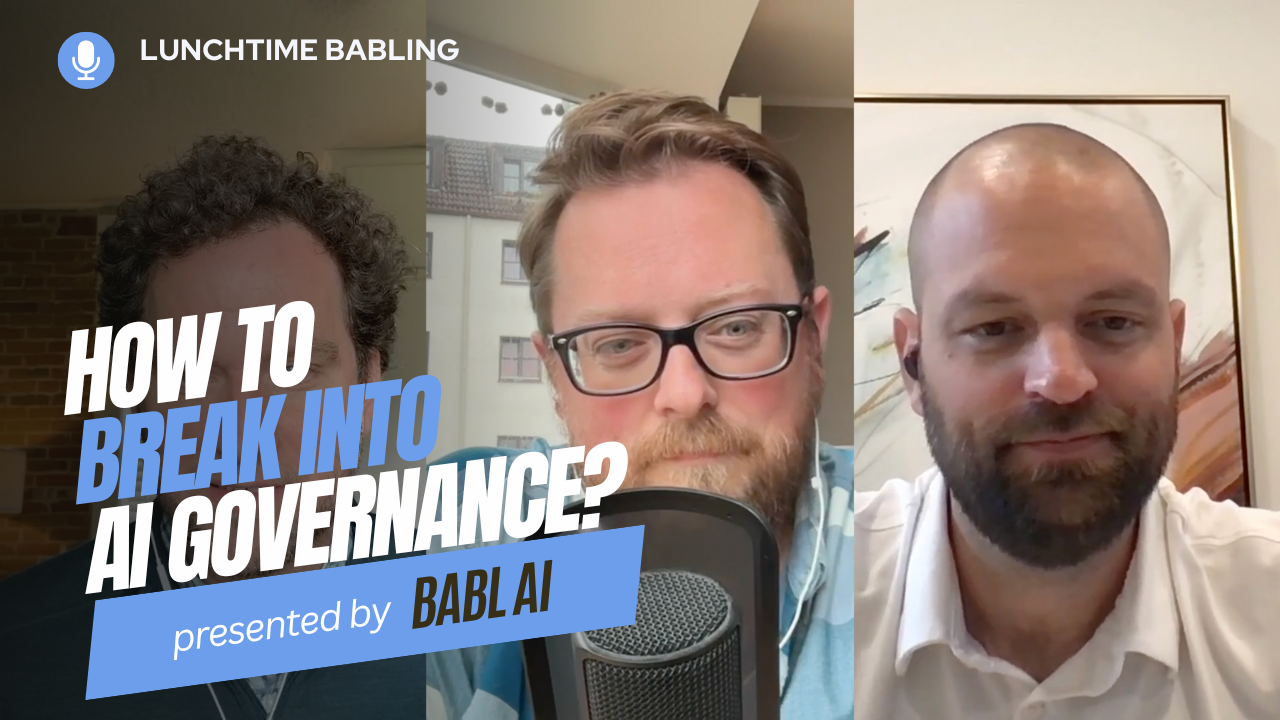Where to Get Started with the EU AI Act: Parts One and Two
As the AI landscape continues to evolve, so too does the regulatory environment surrounding it. One of the most significant developments in this area is the European Union’s AI Act, a comprehensive regulatory framework designed to manage AI risks and ensure responsible use. In a recent two-part series of Lunchtime BABLing, BABL AI CEO Dr. Shea Brown and COO Jeffery Recker explored the EU AI Act, offering practical insights for organizations seeking to navigate this complex regulation.
Part One
Part Two
Here’s a summary of the key points discussed across both episodes:
Understanding the EU AI Act: Objectives and Impact
The EU AI Act is a harmonized regulation that lays down specific rules for the development, deployment, and use of AI systems within the European Union. Its primary objectives are to build trust in AI systems, protect fundamental rights, and ensure that AI technologies are used responsibly. The Act categorizes AI systems into different risk levels, with high-risk systems facing the most stringent requirements.
For organizations outside the EU, the Act still holds significant implications, especially for those providing AI systems to EU customers or deploying AI within the EU. Compliance is not just a European issue; it has global ramifications.
Documentation and Transparency: The Foundation of Compliance
One of the core components of the EU AI Act is the requirement for extensive documentation and transparency. Dr. Brown emphasized the importance of maintaining a well-documented quality management system and technical documentation. These documents are crucial for demonstrating compliance during audits and conformity assessments.
For providers and deployers of AI systems, clear communication between parties is essential. Providers must supply detailed instructions for use, and deployers must adhere to these instructions. The importance of transparency cannot be overstated—without it, organizations risk non-compliance and potential fines.
Challenges for Organizations of All Sizes
Compliance with the EU AI Act presents unique challenges depending on the size of the organization. For smaller companies, limited resources may make it difficult to implement the necessary systems and processes. However, they typically have fewer AI systems to manage, which can simplify the compliance process.
Larger organizations, on the other hand, may struggle with the sheer scale of compliance efforts, especially when AI is integrated across multiple departments and regions. Dr. Brown and Mr. Recker highlighted the importance of conducting a thorough inventory of AI systems, categorizing them by risk level, and deciding whether to centralize or decentralize governance.
Global Compliance: A Strategic Advantage
While the EU AI Act is European by design, its influence extends far beyond the EU. Many global companies are adopting universal AI compliance strategies to prepare for similar laws in other jurisdictions. In the United States, for instance, the Colorado AI Act and New York City’s Local Law 144 mirror many of the EU’s priorities—fairness, transparency, and bias prevention. As Mr. Recker noted, the EU AI Act serves as a “North Star” for global AI governance. Therefore, aligning early with the EU’s framework positions organizations for success under future regulations worldwide.
Enforcement and Penalties: The Stakes are High
The EU AI Act carries substantial penalties for non-compliance. Fines range from 7 million euros for providing misleading information to even higher amounts for breaching high-risk AI requirements. Enforcement will occur through national authorities in each EU member state. However, there may be differences in how individual countries interpret and enforce the law—similar to what occurred under the General Data Protection Regulation (GDPR). Consequently, organizations must monitor developments in every jurisdiction where they operate.
Balancing Innovation and Regulation
Both episodes emphasized that the EU AI Act seeks to balance innovation with oversight. It introduces exemptions for small and medium-sized enterprises (SMEs) and for research projects, encouraging continued innovation while promoting accountability. Furthermore, the introduction of regulatory sandboxes allows companies to collaborate with regulators in a controlled environment. These sandboxes help organizations test compliance approaches and refine AI models before public release. Dr. Brown observed that AI development is moving from hype to trust and safety. Companies that embed ethics and compliance into their design processes are likely to thrive in this new phase.
Looking Ahead: The Future of the EU AI Act
The EU AI Act will continue to evolve as it is implemented. New guidelines, standards, and amendments will emerge as regulators gather feedback from industry and enforcement bodies. Dr. Brown and Mr. Recker stressed that early action is critical. Organizations should begin documenting processes, conducting risk assessments, and strengthening their quality management systems. By acting now, companies can achieve compliance while building a foundation for long-term, responsible AI innovation.
Conclusion
The EU AI Act represents a turning point in how AI is regulated worldwide. The insights shared by Dr. Shea Brown and Jeffery Recker in this two-part series offer a roadmap for companies seeking to adapt. Whether your organization is a small startup or a multinational enterprise, one principle stands out: proactive compliance builds trust. By aligning innovation with accountability, businesses can create AI systems that are safe, transparent, and built to last in an increasingly regulated world.
Where to Find Episodes
Lunchtime BABLing can be found on YouTube, Simplecast, and all major podcast streaming platforms.
Need Help?
For more information and resources on the EU AI Act and AI compliance, be sure to visit BABL AI’s website and stay tuned for future episodes of Lunchtime BABLing





